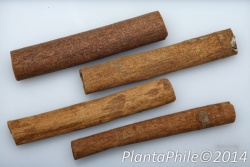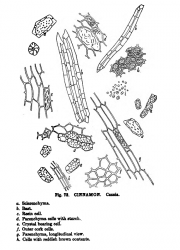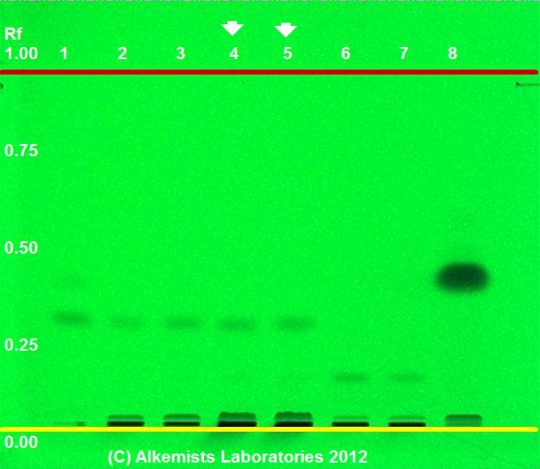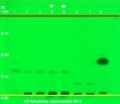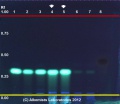Cinnamomum aromaticum (bark)
m |
|||
| (6 intermediate revisions by 2 users not shown) | |||
| Line 1: | Line 1: | ||
| − | {{DISPLAYTITLE:''Cinnamomum aromaticum'' (bark) }} | + | {{DISPLAYTITLE:''Cinnamomum aromaticum'' (bark) }} {{askbox|herb=''Cinnamomum aromaticum''}} |
| − | + | ||
=Nomenclature= | =Nomenclature= | ||
| − | |||
{{nomenclature | binomial=Cinnamomum aromaticum | {{nomenclature | binomial=Cinnamomum aromaticum | ||
|authority=Nees | |authority=Nees | ||
| Line 15: | Line 13: | ||
=Botanical Voucher Specimen= | =Botanical Voucher Specimen= | ||
=Organoleptic Characteristics= | =Organoleptic Characteristics= | ||
| + | {| border=1 | ||
| + | | | ||
| + | {{Macroscopy| source=Schneider, A. (1921) The Microanalysis of Powdered Vegetable Drugs, 2nd ed. | ||
| + | |description= | ||
| + | | color=Cinnamon brown (reddish brown). | ||
| + | | flavor=Sweet, pungent, somewhat astringent. | ||
| + | | scent=Fragrant, aromatic, very characteristic.}} | ||
| + | |} | ||
| + | =Macroscopic Characteristics= | ||
| + | |||
| + | {{ Media | cat=Macroscopy | ||
| + | | source=PlantaPhile | ||
| + | | mainimage=PlantaPhile - 3099.jpg | ||
| + | | companyimage=PlantaPhile logo.jpg | ||
| + | | companyURL=http://plantaphile.com/ | ||
| + | | }} | ||
| − | |||
=Microscopic Characteristics= | =Microscopic Characteristics= | ||
| + | {| border=1 | ||
| + | | | ||
{{Microscopy | source=Schneider, A. (1921) The Microanalysis of Powdered Vegetable Drugs, 2nd ed. | {{Microscopy | source=Schneider, A. (1921) The Microanalysis of Powdered Vegetable Drugs, 2nd ed. | ||
| − | |||
| description=Cassia (bark) (''Cinnamomum aromaticum'') (''Cinnamomum cassia'' auct.) | | description=Cassia (bark) (''Cinnamomum aromaticum'') (''Cinnamomum cassia'' auct.) | ||
| − | |||
| − | |||
| − | |||
| characteristics=Rather short, thick walled bast cells sclerenchyma with cell walls unequally thickened parenchyma cells with compound starch granules; cells with numerous small prismatic crystals; large resin bearing cells; cells of outer bark suberized and with reddish brown contents. Cassia bark contains relatively more starch than do the other varieties of cinnamon barks and relatively less bast tissue. | | characteristics=Rather short, thick walled bast cells sclerenchyma with cell walls unequally thickened parenchyma cells with compound starch granules; cells with numerous small prismatic crystals; large resin bearing cells; cells of outer bark suberized and with reddish brown contents. Cassia bark contains relatively more starch than do the other varieties of cinnamon barks and relatively less bast tissue. | ||
| ash=Ash about 6.5 per cent. | | ash=Ash about 6.5 per cent. | ||
| adulterants=Cassia cinnamon in particular is likely to be adulterated with inferior cassia barks, clove bark, flour, inert vegetable substances. The quality of cassia cinnamon is proportionate to the number of bast cells present. The very inferior grades show few bast cells, which indicates that the outer older bark tissue predominates. Cassia could readily be graded according to the bast cell count. The organoleptic tests, especially taste and odor, are also valuable guides to quality. | | adulterants=Cassia cinnamon in particular is likely to be adulterated with inferior cassia barks, clove bark, flour, inert vegetable substances. The quality of cassia cinnamon is proportionate to the number of bast cells present. The very inferior grades show few bast cells, which indicates that the outer older bark tissue predominates. Cassia could readily be graded according to the bast cell count. The organoleptic tests, especially taste and odor, are also valuable guides to quality. | ||
| }} | | }} | ||
| − | + | {{Media | cat=Microscopy | source=Schneider, A. (1921) The Microanalysis of Powdered Vegetable Drugs, 2nd ed. | |
| + | | mainimage=Microanalysis_powdered_vegetable_google_ver_cinnamon_cassia.png}} | ||
| + | |} | ||
=High Performance Thin Layer Chromatographic Identification= | =High Performance Thin Layer Chromatographic Identification= | ||
Latest revision as of 17:54, 2 June 2014
Contents |
Nomenclature
Cinnamomum aromaticum Nees Lauraceae
Syn. Cinnamomum cassia auct.
Standardized common name (English): cassia
Pinyin name(s): rou gui; rou gui (bark); gui zhi (twig)
Botanical Voucher Specimen
Organoleptic Characteristics
|
Macroscopic Characteristics
|
|
Microscopic Characteristics
|
High Performance Thin Layer Chromatographic Identification
|
Cassia (bark) (Cinnamomum aromaticum Nees) Lane Assignments Lane 2(3μl) Cinnamomum aromaticum / Cinnamomum cassia (bark); Lane 3(3μl) Cinnamomum aromaticum / Cinnamomum cassia (bark); Lane 6(3μl) Cinnamomum verum (bark); Lane 7(3μl) Cinnamomum verum (bark) authenticated by macroscopic, microscopic &/or TLC studies according to the reference source cited below, held at Alkemists Pharmaceuticals, Costa Mesa, CA. Stationary Phase Silica gel 60, F254, 10 x 10 cm HPTLC plates Mobile Phase toluene: ethyl acetate [9.5/0.5] Sample Preparation Method 0.3g+3mL CH3OH sonicate/heat @~50° C ~ 1/2 hr. Detection Method Image 1 UV 254 nm; Image 2 10% Ethanolic KOH Reagent 365 nm Reference see Method Developed by Alkemist Laboratories Source: Elan M. Sudberg, Alkemist Laboratories [5] |
Supplementary Information
Sources
- ↑ Schneider, A. (1921) The Microanalysis of Powdered Vegetable Drugs, 2nd ed.
- ↑ PlantaPhile http://plantaphile.com/
- ↑ Schneider, A. (1921) The Microanalysis of Powdered Vegetable Drugs, 2nd ed.
- ↑ Schneider, A. (1921) The Microanalysis of Powdered Vegetable Drugs, 2nd ed.
- ↑ Elan M. Sudberg, Alkemist Laboratories http://www.alkemist.com
